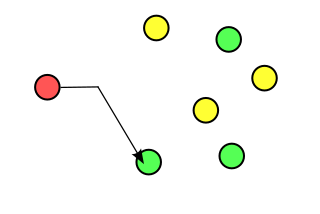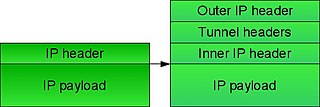Interior Gateway Routing Protocol (IGRP) is a distance vector interior gateway protocol (IGP) developed by Cisco. It is used by routers to exchange routing data within an autonomous system.
The Internet Control Message Protocol (ICMP) is a supporting protocol in the Internet protocol suite. It is used by network devices, including routers, to send error messages and operational information indicating success or failure when communicating with another IP address. For example, an error is indicated when a requested service is not available or that a host or router could not be reached. ICMP differs from transport protocols such as TCP and UDP in that it is not typically used to exchange data between systems, nor is it regularly employed by end-user network applications.

Internet Protocol version 4 (IPv4) is the fourth version of the Internet Protocol (IP). It is one of the core protocols of standards-based internetworking methods in the Internet and other packet-switched networks. IPv4 was the first version deployed for production on SATNET in 1982 and on the ARPANET in January 1983. It is still used to route most Internet traffic today, even with the ongoing deployment of Internet Protocol version 6 (IPv6), its successor.
The Internet Protocol (IP) is the network layer communications protocol in the Internet protocol suite for relaying datagrams across network boundaries. Its routing function enables internetworking, and essentially establishes the Internet.

A router is a computer and networking device that forwards data packets between computer networks, including internetworks such as the global Internet.

Border Gateway Protocol (BGP) is a standardized exterior gateway protocol designed to exchange routing and reachability information among autonomous systems (AS) on the Internet. BGP is classified as a path-vector routing protocol, and it makes routing decisions based on paths, network policies, or rule-sets configured by a network administrator.
Intermediate System to Intermediate System is a routing protocol designed to move information efficiently within a computer network, a group of physically connected computers or similar devices. It accomplishes this by determining the best route for data through a packet switching network.
Open Shortest Path First (OSPF) is a routing protocol for Internet Protocol (IP) networks. It uses a link state routing (LSR) algorithm and falls into the group of interior gateway protocols (IGPs), operating within a single autonomous system (AS).
The Routing Information Protocol (RIP) is one of the oldest distance-vector routing protocols which employs the hop count as a routing metric. RIP prevents routing loops by implementing a limit on the number of hops allowed in a path from source to destination. The largest number of hops allowed for RIP is 15, which limits the size of networks that RIP can support.
Enhanced Interior Gateway Routing Protocol (EIGRP) is an advanced distance-vector routing protocol that is used on a computer network for automating routing decisions and configuration. The protocol was designed by Cisco Systems as a proprietary protocol, available only on Cisco routers. In 2013, Cisco permitted other vendors to freely implement a limited version of EIGRP with some of its associated features such as High Availability (HA), while withholding other EIGRP features such as EIGRP stub, needed for DMVPN and large-scale campus deployment. Information needed for implementation was published with informational status as RFC 7868 in 2016, which did not advance to Internet Standards Track level, and allowed Cisco to retain control of the EIGRP protocol.
In the seven-layer OSI model of computer networking, the network layer is layer 3. The network layer is responsible for packet forwarding including routing through intermediate routers.
A distance-vector routing protocol in data networks determines the best route for data packets based on distance. Distance-vector routing protocols measure the distance by the number of routers a packet has to pass; one router counts as one hop. Some distance-vector protocols also take into account network latency and other factors that influence traffic on a given route. To determine the best route across a network, routers using a distance-vector protocol exchange information with one another, usually routing tables plus hop counts for destination networks and possibly other traffic information. Distance-vector routing protocols also require that a router inform its neighbours of network topology changes periodically.

Anycast is a network addressing and routing methodology in which a single IP address is shared by devices in multiple locations. Routers direct packets addressed to this destination to the location nearest the sender, using their normal decision-making algorithms, typically the lowest number of BGP network hops. Anycast routing is widely used by content delivery networks such as web and name servers, to bring their content closer to end users.
A stub network, or pocket network, is a somewhat casual term describing a computer network, or part of an internetwork, with no knowledge of other networks, that will typically send much or all of its non-local traffic out via a single path, with the network aware only of a default route to non-local destinations. As a practical analogy, think of an island which is connected to the rest of the world through a bridge and no other path is available either through air or sea. Continuing this analogy, the island might have more than one physical bridge to the mainland, but the set of bridges still represents only one logical path.
A broadcast address is a network address used to transmit to all devices connected to a multiple-access communications network. A message sent to a broadcast address may be received by all network-attached hosts.

An IP tunnel is an Internet Protocol (IP) network communications channel between two networks. It is used to transport another network protocol by encapsulation of its packets.
The internet layer is a group of internetworking methods, protocols, and specifications in the Internet protocol suite that are used to transport network packets from the originating host across network boundaries; if necessary, to the destination host specified by an IP address. The internet layer derives its name from its function facilitating internetworking, which is the concept of connecting multiple networks with each other through gateways.
In network routing, the control plane is the part of the router architecture that is concerned with establishing the network topology, or the information in a routing table that defines what to do with incoming packets. Control plane functions, such as participating in routing protocols, run in the architectural control element. In most cases, the routing table contains a list of destination addresses and the outgoing interface(s) associated with each. Control plane logic also can identify certain packets to be discarded, as well as preferential treatment of certain packets for which a high quality of service is defined by such mechanisms as differentiated services.
IP routing is the application of routing methodologies to IP networks. This involves not only protocols and technologies but includes the policies of the worldwide organization and configuration of Internet infrastructure. In each IP network node, IP routing involves the determination of a suitable path for a network packet from a source to its destination in an IP network. The process uses static configuration rules or dynamically obtained from routing protocols to select specific packet forwarding methods to direct traffic to the next available intermediate network node one hop closer to the desired final destination, a total path potentially spanning multiple computer networks.
An interior gateway protocol (IGP) or Interior routing protocol is a type of routing protocol used for exchanging routing table information between gateways within an autonomous system. This routing information can then be used to route network-layer protocols like IP.





